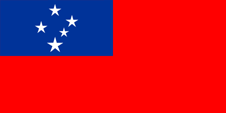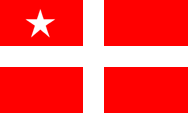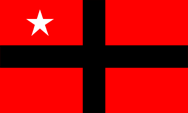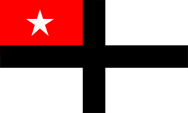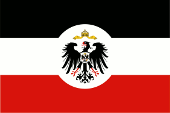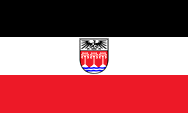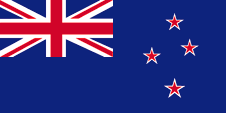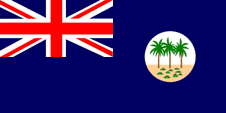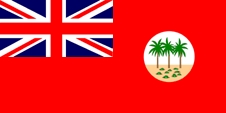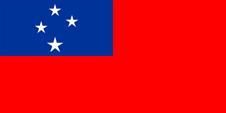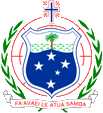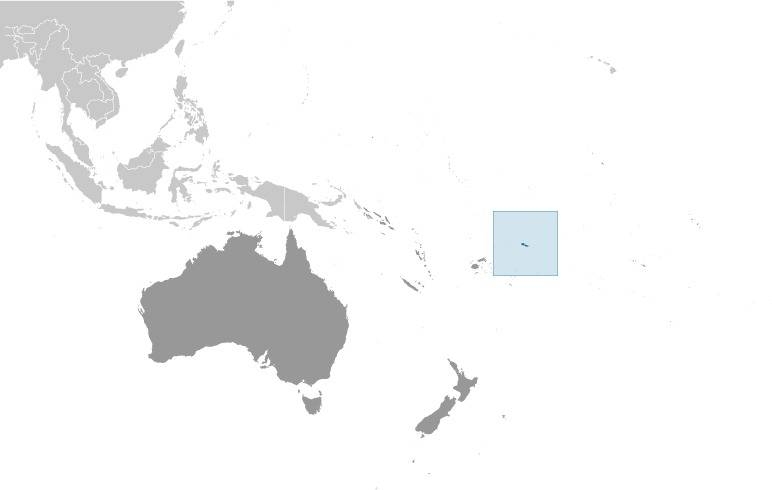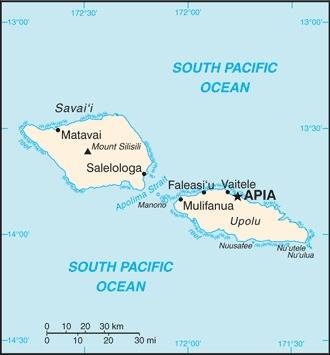Die heutige Flagge von Samoa wurde am 26.05.1948 im Zusammenhang mit der Annahme
einer neuen Verfassung als Flagge des damaligen Westsamoa offiziell
eingeführt. Sie wurde von König Malietoa Tanumafili a Tupu Tamasese Mea'ole
entworfen und zeigt ein einfarbiges rotes Grundtuch mit einer blauen
Oberecke, darin fünf Sterne, das "Kreuzes des Südens". Bis 1949 waren es nur
vier Sterne. Die Flagge wurde bei der Erreichen der Unabhängigkeit im Jahre
1962 beibehalten.
The
today's flag of Samoa was officially introduced on 26th of May in 1948 in
occasion of the adoption of a new constitution as the flag of the then
Western Samoa. It was designed by King Malietoa Tanumafili a Tupu Tamasese
Mea'ole and shows a single-coloured red bunting with a blue upper corner, in
it five stars, forming the "Southern Cross".
Until 1949 there were only four stars. The flag was kept at the achievement
of independence in 1962.
Rot steht
für Mut und Tapferkeit, Weiß für Reinheit, Blau für Freiheit. Blau
symbolisiert aber auch den Himmel und das Meer. Das "Kreuz des Südens"
findet sich auch in anderen Flaggen der südlichen Hemisphäre, ist also ein
Symbol von hoher regionaler Bedeutung.
Red
stands for courage and valor, white for purity, blue for freedom. But also
symbolizes the blue heaven and the sea. The "Southern Cross" is also to
found in other flags of the southern Hemisphere, is indubityble a symbol of
great regional significance.
Die erste
Flagge Samoas wurde am 02.10.1873 eingeführt. Sie zeigte ein rotes Grundtuch
mit einem durchgehenden weißen Kreuz und einem weißen Stern in der Oberecke.
Die Könige der ab 1879 regierenden Malietoa-Dynastie nahmen sich dieser
Flagge an. Andere Dynastien (Tamasese, Tuiaana) verwendeten nach dem
gleichen Grundmuster gestaltete Flaggen, jedoch mit einem schwarzen Kreuz,
oder einem weißen Grundtuch.
The first
flag of Samoa was introduced on 2nd of October in 1873. It showed a red
bunting with an until the border of the flag reaching white cross and a
white star in the upper corner.
The kings of the since 1879 reigning Malietoa dynasty took care of this
flag. Other dynasties (Tamasese, Tuiaana) used by the same basic pattern
designed flags, but with a black cross, or a white bunting.
Als
deutsche Kolonie verwendete das Land keine besondere Nationalflagge. Es
galten die Farben des Deutschen Reiches: Schwarz, Weiß und Rot. Behörden
verwendeten die Flagge des Kolonialamtes sowie Abarten davon. Diese war zwar
schwarz, weiß und rot waagerecht gestreift und zeigte in der Mitte eine weiße Scheibe mit dem Reichsadler.
As a German colony, the country did not use an own or special flag.
There were used the colors of the German Empire: black, white and red.
Authorities used the flag of the Colonial Office as well as varieties of it.
That was black, white and red horizontally striped and showed in the middle
of it a white disc with the imperial eagle.
Ab 1913 wurde überlegt, für die Kolonien eigene Hoheitszeichen zu schaffen.
Erste Entwürfe lagen 1914 vor, jedoch wurde das Projekt wegen des Ausbruchs
des Ersten Weltkriegs und wegen des Verlusts der Kolonien nicht mehr
realisiert.
From 1913 it was considered to create own emblems for the colonies. First drafts were
made in 1914, but the project was not realized because of the outbreak
of the First World War and because of the loss of the colonies.
Nachdem
die Inseln von Neuseeland besetzt worden waren, wurde die Flagge Neuseelands
verwendet. Neuseeland ersuchte die Admiralität Großbritanniens im Jahre 1921
um die Genehmigung für einen eigenen blauen und roten Ensign.
After the
islands had been occupied by troops of New Zealand, there was only in use
the flag of New Zealand. New Zealand asked the British Admiralty in 1921 for approval of an own Blue
and Red Ensign.
Großbritannien hatte in Jahr 1864 ein Flaggensystem eingeführt, in dem:
- Kriegsschiffe einen
sogenannten "White Ensign" (Marineflagge), eine weiße Flagge oft mit
durchgehendem roten Georgskreuz und mit dem Union Jack in der Oberecke,
- Handelsschiffe
einen "Red Ensign" (auch "Civil Ensign" => Bürgerflagge genannt, die
eigentl. Handelsflagge), eine rote Flagge mit dem Union Jack in der
Oberecke, und
- Dienstschiffe einen
"Blue Ensign" (Regierungsflagge => die eigentl. Staatsflagge), eine blaue
Flagge mit dem Union Jack in der Oberecke führten.
Seit 1865 durften
Schiffe von Kolonialregierungen einen Blue Ensign mit einem Badge
(Abzeichen) im fliegenden Ende führen.
Die jeweiligen
Regierungen sollten entsprechene Bagdes zur Verfügung stellen.
Handelsschiffe und seefahrende Privatpersonen aus Kolonien dürfen nur dann
einen Red Ensign mit Badge führen, wenn von der britischen Admiralität eine
entsprechende Erlaubnis für die Kolonie erteilt wurde. |
Great
Britain introduced a flag system in 1864 in which:
- war ships fly the
"White Ensign" (naval flag), a white flag often with an uninterrupted red
St. George's-Cross and with the Union Jack in the upper staff quadrant of
the flag,
- merchant ships fly
a "Red Ensign" (also named "Civil Ensign" => civil flag, the real merchant
flag), a red flag with the Union Jack in the upper staff quadrant of the
flag, and
- governmental ships
fly the "Blue Ensign" (flag for the use by the gouvernment => the actual
state flag), a blue flag with the Union Jack in the upper staff quadrant
of the flag.
Since 1865 ships of
colonial governments were permitted to fly the Blue Ensign with a badge in
the flying end of the flag. The respective governments were asked to design
appropriate badges. Merchant ships and seafaring persons from colonies were
only permitted to use the Red Ensign with a badge, then also named Civil
Ensign, if permission has been given to the respective colony by the British
admiralty.
Diese
Erlaubnis wurde erteilt, so dass ein "Red Ensign", ein rotes Flaggentuch mit
dem britischen Union Jack in der Oberecke und dem Badge der Kolonie als
Handelsflagge verwendet werden konnte. Das Badge von Samoa zeigte drei
Palmen, eine Symbolik, die bis auf die Zeit als deutsche Kolonie
zurückreicht.
This
permission was given, and it was possible to use a "Red Ensign", a red
bunting with the British Union Jack in the upper staff quadrant and the
badge of the colony as merchant flag. The badge of Samoa showed three palm
trees, a symbolism that goes back to the time as a German colony.
Die
Flaggen nach dem Muster britischer Kolonien wurden bis zur Unabhängigkeit im
Jahre 1962 verwendet.
The
flags, basing on the model of British colonies were used until independence
in 1962. |
